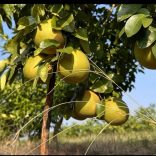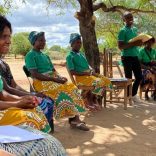Cotton exports brought Mozambique US$120.9 million in revenue over five years but fell by half in 2024.
Mozambique: Cashew sector growth transforming community livelihoods, says Agriculture Ministry

File photo: RFI
Mozambique’s Ministry of Agriculture has said that the sharp increase in cashew production and trade is having a positive impact on the quality of life in local communities, though it stressed the need to maintain quality standards and follow best practices.
A note released following the visit on Wednesday by the Minister of Agriculture, Environment and Fisheries, Roberto Albino, to the Cotton and Oilseeds Institute (IAOM), states that the cashew nut production and marketing plan showed “a positive performance in the 2024–2025 season”, with output exceeding 195,000 tonnes, above the initial target of 160,000 tonnes.
“Thanks to good agricultural practices and the commitment of producers, this growth has had a direct impact on communities, allowing many families to improve their living conditions, with access to housing, education, and other goods and services that meet their basic needs,” the note reads.
Despite the progress, the minister stressed that “quantity must go hand in hand with quality”, identifying as a priority the strengthening of the cashew nut value chain.
According to the Ministry of Agriculture, “the development project for this value chain, presented during the meeting, is scheduled for implementation between 2025 and 2035 and will be led by the IAM itself. The objective is to create jobs, increase competitiveness, and promote the export of processed products”.
The IAM has also been instructed “to study the best practices of leading cashew-producing and trading countries, such as Côte d’Ivoire, and to adopt innovative strategies adapted to the national context”.
“We must do things differently with what we have – and do them well,” Albino urges in the statement.
READ: They’re on the rise: Could these be the next shooting stars of Mozambique’s exports?
Mozambique decided earlier this month to maintain the producer reference price for cashew nuts at 45 meticais (€0.61) per kilo for the current marketing season, to ensure the sustainability of one of the country’s key cash crops.
“We will maintain the reference price at 45 meticais. We will continue to monitor market conditions, and there is nothing preventing this committee from meeting again to discuss setting a new reference price should market fluctuations require it,” said Secretary of State for the Sea and Fisheries, Momade Juízo, on 10 October.
He was speaking in Maputo during the first session of the Oilseeds Committee, which meets annually to define the producer reference price for each cashew nut marketing campaign.
Cashew nut sales in Mozambique reached around 195,400 tonnes in the 2024/2025 campaign, marking a historic milestone close to the record levels of the 1970s, when the country was one of the world’s leading producers.
Cashew nut exports from Mozambique continue to grow, reaching US$38.7 million (€33 million) in the first quarter, making it the country’s top-performing traditional export product, according to data from the Bank of Mozambique.
According to the Ministry of Agriculture, Environment and Fisheries, Mozambique’s cashew production peaked 50 years ago, during the colonial period, at more than 200,000 tonnes per year. By the mid-1970s, Mozambique was the world’s second-largest cashew producer (210,000 tonnes processed in 1973), behind only India, which then — and still today — purchases a large share of Mozambique’s output.
After the country’s independence on 25 June 1975, production fell to less than 10% of that figure, to around 15,000 to 20,000 tonnes per year. However, output has been increasing annually, and in the 2024/2025 campaign, Mozambique stood among the top global producers, maintaining its position as the seventh largest.













Leave a Reply
Be the First to Comment!
You must be logged in to post a comment.
You must be logged in to post a comment.